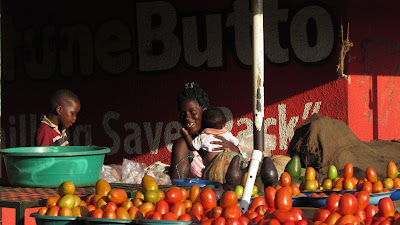We arrived in Uganda Saturday afternoon after 35 hours in transit door to door. All luggage arrived intact and only one leg of the three flights was delayed one hour. All in all, pretty good! We spent Sunday getting essentials like cash, cell phone etc. squared away (yes, the ATM ate my card).
Sunday evening we met with long time Gretta volunteer, and a Gretta Scholar herself, Sister Cathy from the Uganda Catholic Medical Bureau. Sister Cathy oversees all the nursing training in Catholic institutions in Uganda, considered by most to be the best. We were thrilled when Sister Cathy agreed to join our Advisory Board; she seemed pretty excited too!
Monday we had a meeting for most of the day with our potential partner on our Private Practice Midwife program, Jhipiego. The meetings will continue the rest of the week as we drill down on the details of implementation.
Tuesday was a crazy day. After an exhausting but productive meeting with Jhipiego we dashed over to the Ugandan Catholic Medical Bureau. Moving about in Kampala is truly an amazing feat in itself. The traffic is horribly congested with boda bodas (motorcycles), cars, and pedestrians all swerving to avoid each other, and pot holes, while vying for space. Oh yes, all with the smell of diesel exhaust. Sometimes we just have to close our eyes. At least the government finally outlawed livestock roaming on the roads! Ambulances aren't given any priority. When asked why, our driver said people don't believe the ambulance is really on business but using the lights to get through traffic faster!
Our visit at the UCMB was short but impressionable. When asked how things were, the Executive Secretary explained that funding has shrunk incredibly (as with most organizations). Dr. Orach was so warm yet weary. His plea was for us to help "scale up" the current staff in the Catholic hospitals to a registered nurse. The patients in the hospital are suffering for lack of qualified nursing care. We promised to do our best.
We then made a quick stop to drop off beautiful dresses from Dress A Girl at an orphanage run by the church. We had the treat of visiting the toddlers. We were immediately swarmed by adorable children all eager to be held. There are dedicated staff and volunteers at the orphanage but never enough arms for all the loving children. We wanted to stay and play but had another appointment so Sr. Cathy herded us to the car.
Our next stop was at the Nsambya School of Nursing. Seven of our TGF graduates were there to greet us in their graduation caps and gowns. Many had travelled hours and days just to thank us personally for providing their nursing scholarship. All were happily employed and shared with us amazing stories of life saving work. Imagine travelling 500 km. on crowded, hot bus over bumpy, dusty roads just to spend two hours then return home. One of the scholars had gotten in an accident on her way. Another had problems with a vehicle that had broken down.
Current TGF scholars at the school joined us and joined in a song of gratitude for TGF, donors, and volunteers. There were signs and gifts as well. We then celebrated over a typical Ugandan meal prepared by the school. The picture above is of one of the graduates. Two of the current scholars presented us with lovely letters of gratitude; one saying "I had actually lost hope and began to see no more future for me but big thanks to The Gretta Foundation who rescued me and brought me hope for a brighter future". Talk about motivation for us during an exhausting trip. Sister Cathy drove us home (it's comforting to have a nun/nurse at the wheel as we threaded the gauntlet of traffic). How does she keep her habit so white?
Tomorrow is another day today of meetings with Jhipiego, and meeting tonight with long time friend of The Gretta Foundation, Dr. Nelson Musoba with The Ugandan AIDS Commission. Thank you again to all The Gretta Foundation supporters, donors and volunteers. Your support is making an incredible difference in the lives of thousands of people.
 Our wonderful Sr. Carmel took us through the hospital where we saw mothers in various stages of labour. This photo shows a small bundle of cloth on the back counter. We opened the cloth and met Baby Sean. Baby Sean would have been the first born to his parents but died because his mother refused a cesarean section until the last moment.
Our wonderful Sr. Carmel took us through the hospital where we saw mothers in various stages of labour. This photo shows a small bundle of cloth on the back counter. We opened the cloth and met Baby Sean. Baby Sean would have been the first born to his parents but died because his mother refused a cesarean section until the last moment. 










